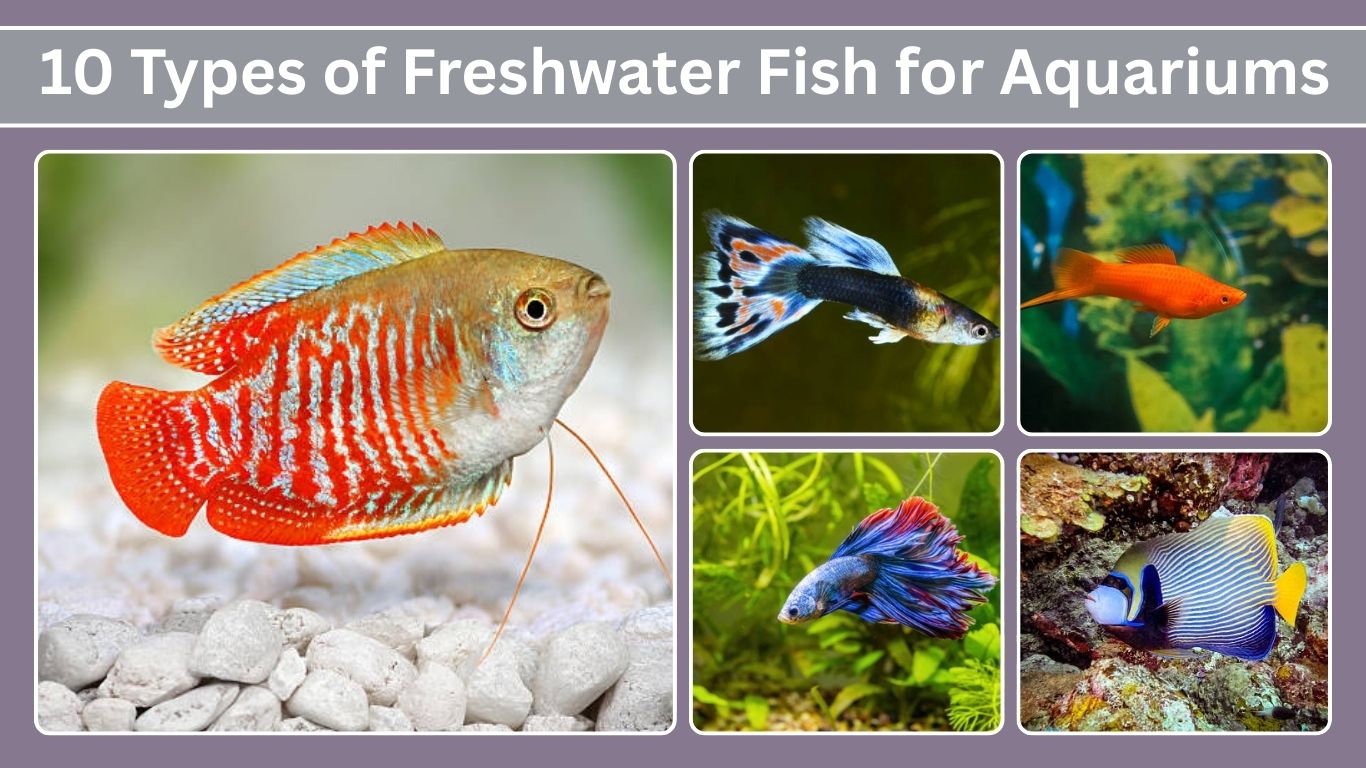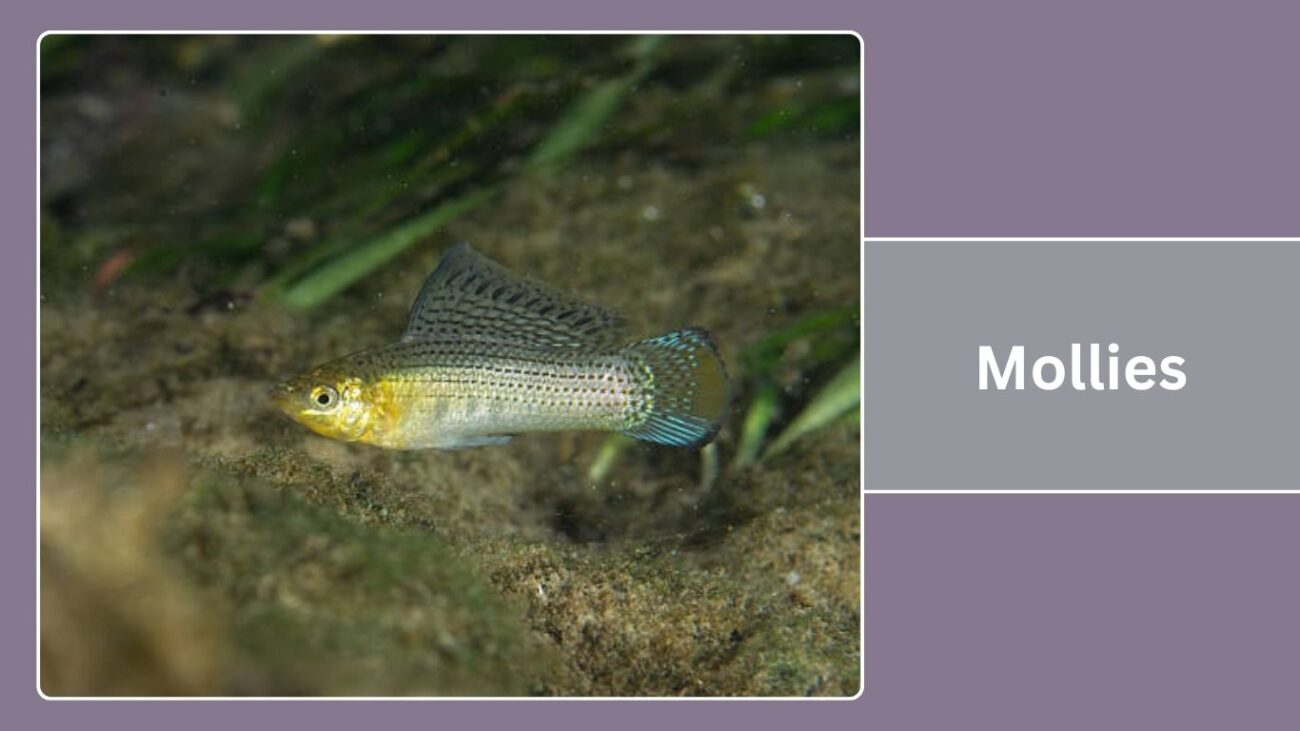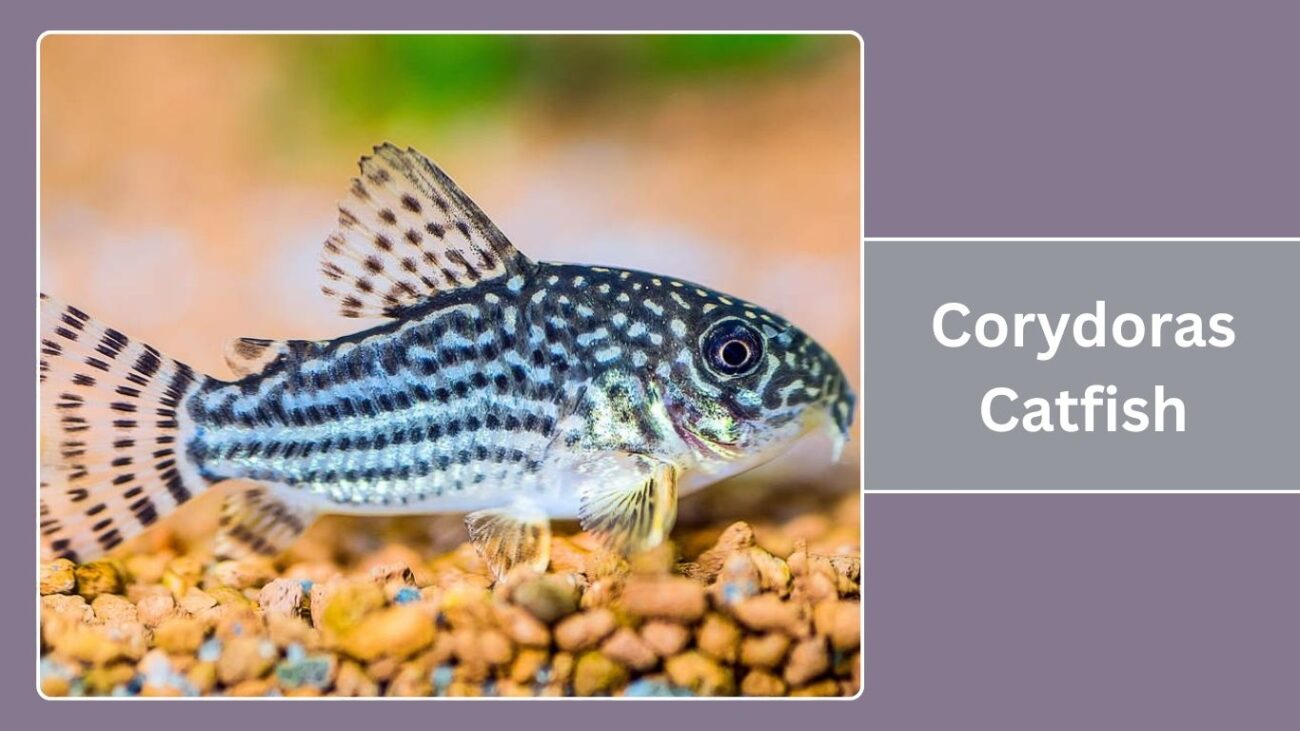Freshwater aquariums bring beauty, relaxation, and life into homes, and choosing the right fish is key to a healthy, thriving tank. From colorful guppies to peaceful corydoras catfish, freshwater fish come in a wide range of sizes, behaviors, and care needs. This guide explores 10 popular freshwater fish species that are beginner-friendly, vibrant, and perfect for community tanks, helping you decide which ones suit your aquarium best.
1. Guppy
Guppies are among the most popular freshwater aquarium fish, loved for their bright colors, lively nature, and easy care requirements. They are beginner-friendly and adapt well to community tanks, making them a favorite for home aquariums.
Identification
- Small size, usually 1.5–2.5 inches long
- Males are colorful with flowing tails
- Females are larger, less vibrant, and have rounder bodies
Habitat and Tank Requirements
Guppies thrive in freshwater tanks with temperatures between 72–82°F. They prefer aquariums with live plants, hiding spots, and good filtration. A 10-gallon tank is suitable for a small group, but larger tanks work best for breeding.
Behavior
They are peaceful, active swimmers that do well in community tanks. Males often display courtship behavior, and groups are more lively when kept in small schools.
Diet
Guppies are omnivorous and eat flakes, pellets, brine shrimp, and daphnia. A varied diet ensures brighter colors and healthier growth.
2. Neon Tetra
Neon Tetras are small, brightly colored fish that bring a striking glow to aquariums. Their shimmering blue and red stripes make them stand out, and their peaceful nature makes them a top choice for community tanks.
Identification
- Small fish, about 1.5 inches long
- Bright blue horizontal stripe across the body
- Red stripe from the middle to the tail
- Transparent fins
Habitat and Tank Requirements
They prefer slightly acidic, soft water with temperatures between 70–81°F. A 10-gallon planted tank with dim lighting works well to mimic their natural habitat. Larger groups are better, as they thrive when kept in schools of six or more.
Behavior
Neon Tetras are peaceful schooling fish that swim in harmony. They stay near the middle of the tank and add constant motion, making them excellent community tank mates.
Diet
They are omnivores and eat flakes, micro-pellets, and tiny live or frozen foods like brine shrimp and daphnia. A balanced diet helps maintain their vivid colors.
3. Betta Fish
Betta Fish, also called Siamese fighting fish, are famous for their vivid colors and long, flowing fins. They are hardy and suitable for small aquariums, though they need specific care to remain healthy. Their beauty and personality make them one of the most kept freshwater aquarium fish worldwide.
Identification
- Medium size, usually 2–3 inches long
- Males have long, flowing fins while females are shorter-finned
- Wide range of colors: red, blue, green, yellow, white, and multicolored varieties
- Males are more vibrant and territorial than females
Habitat and Tank Requirements
Bettas need warm water between 76–82°F. While many people keep them in small bowls, they actually thrive in filtered tanks of 5 gallons or more. They prefer tanks with gentle water flow, plants for resting, and hiding spots. Because they have a labyrinth organ, they can breathe air directly from the surface, so the water should not be too deep without access to open air.
Behavior
Male bettas are highly territorial and should not be kept with other males. However, they can sometimes live with peaceful community fish like snails, corydoras, or certain tetras if the tank is large enough. Bettas are intelligent and curious, often recognizing their owners and responding to feeding time.
Diet
Bettas are carnivorous and need a protein-rich diet. Specialized betta pellets, frozen or live foods like brine shrimp, mosquito larvae, and bloodworms are ideal. Overfeeding should be avoided, as bettas are prone to bloating and digestive issues.
4. Zebra Danio
Zebra Danios are energetic, hardy freshwater fish, easily recognized by their horizontal stripes. They are excellent for beginners because of their adaptability and active swimming behavior. Their constant motion adds life and vibrancy to any community aquarium.
Identification
- Small fish, about 2 inches long
- Silver or golden body with 5–6 bold blue or purple horizontal stripes
- Slender, torpedo-shaped body
- Fins are usually short and transparent
Habitat and Tank Requirements
They thrive in freshwater aquariums with temperatures between 65–77°F, making them suitable for unheated tanks as well. A minimum of 10 gallons is recommended, but larger tanks give them more space to school. They prefer tanks with both open swimming areas and plants for hiding. Their hardy nature allows them to tolerate a wide range of water conditions.
Behavior
Zebra Danios are schooling fish and should be kept in groups of at least five or more to feel secure. They are peaceful and do well with most other community fish. These fish are very active swimmers, often darting around the tank, which keeps the aquarium lively.
Diet
They are omnivores and will readily accept flakes, pellets, and small live or frozen foods such as brine shrimp, daphnia, and bloodworms. A balanced diet keeps them healthy and enhances their striped coloration.
5. Angelfish
Angelfish are graceful freshwater fish known for their tall, triangular bodies and flowing fins. They are often considered the centerpiece of community aquariums because of their striking appearance and elegant swimming style. With a variety of color patterns available, they are a favorite among aquarists.
Identification
- Medium to large size, growing up to 6 inches long and 8 inches tall
- Distinct triangular body shape with long, pointed fins
- Found in colors like silver, black, marble, koi, and gold
- Many varieties have vertical dark stripes across the body
Habitat and Tank Requirements
Angelfish thrive in warm, soft to moderately hard water with temperatures between 75–82°F. A tank of at least 20 gallons is required, but larger, taller aquariums are preferred to accommodate their body height. They do well in planted aquariums with driftwood and open swimming space. A gentle water current suits them best.
Behavior
Generally peaceful, angelfish can become territorial during breeding or when defending their space. They mix well with medium-sized community fish but may prey on very small species like tiny tetras or fry. They are intelligent fish that show unique personalities and interactions.
Diet
Angelfish are omnivores that enjoy a varied diet. They eat flakes, pellets, frozen foods, and live options such as brine shrimp and bloodworms. Including plant-based food or vegetables helps balance their diet and maintain overall health.
6. Mollies
Mollies are versatile and beginner-friendly freshwater fish that come in many varieties and colors. They are livebearers, meaning they give birth to fully formed fry instead of laying eggs, which makes them especially interesting for aquarists who enjoy breeding. Their peaceful nature and adaptability make them ideal for community tanks.
Identification
- Average size ranges from 3 to 4.5 inches, depending on the type
- Body shapes vary: common, sailfin, and lyretail are popular varieties
- Colors include black, white, orange, gold, dalmatian, and mixed patterns
- Males are slimmer with longer dorsal fins; females are larger and rounder
Habitat and Tank Requirements
Mollies thrive in tanks with temperatures between 72–82°F. They prefer slightly alkaline water and can even tolerate brackish conditions. A minimum of 20 gallons is recommended, especially since they breed frequently and can quickly increase tank population. Live plants, smooth decorations, and open swimming space make their environment more natural and stress-free.
Behavior
They are peaceful and social fish that do well in community tanks. Mollies are active swimmers and should be kept in small groups. To avoid stress, it’s best to keep a higher ratio of females to males, since males often chase females during breeding.
Diet
Mollies are omnivorous and enjoy a mix of plant matter and protein. They eat flakes, pellets, algae wafers, blanched vegetables like spinach or zucchini, and live or frozen foods such as brine shrimp and bloodworms. A balanced diet enhances their colors and supports healthy fry development.
7. Swordtail
Swordtails are attractive freshwater fish known for their unique tail shape, which resembles a sword. They are hardy, easy to care for, and available in a wide range of colors. Because of their active nature and adaptability, they are often recommended for community aquariums.
Identification
- Medium-sized fish, usually 4–5 inches long
- Males have an extended, sword-like lower tail fin
- Females are larger but lack the sword-shaped extension
- Colors include red, green, orange, black, and mixed patterns
Habitat and Tank Requirements
Swordtails thrive in tanks with temperatures between 72–82°F. A 20-gallon or larger aquarium is recommended, as they are active swimmers that need space. They prefer slightly alkaline water and do well in planted tanks with open areas for free swimming. Since they are livebearers, extra tank space is important to prevent overcrowding when fry are born.
Behavior
They are peaceful but active fish, suitable for community tanks. Males may occasionally chase each other to establish dominance, so it’s best to keep one male with multiple females. Swordtails spend most of their time in the middle and upper levels of the aquarium.
Diet
Swordtails are omnivores and enjoy a varied diet. They readily eat flakes, pellets, live foods such as brine shrimp, and vegetables like blanched peas or spinach. A mix of protein and plant-based food helps them stay healthy and vibrant.
8. Gourami
Gouramis are colorful freshwater fish known for their calm temperament and graceful swimming style. With their labyrinth organ, they can breathe atmospheric air, making them adaptable to different aquarium conditions. Their beauty and peaceful nature make them a popular choice for community tanks.
Identification
- Size ranges from 2 inches (dwarf gourami) to 6 inches (larger species)
- Slender, oval-shaped body with long, thin feeler-like ventral fins
- Available in many colors: blue, gold, pearl, honey, and red varieties
- Males are usually more colorful and slimmer than females
Habitat and Tank Requirements
Gouramis thrive in aquariums with temperatures between 74–82°F. A minimum of 20 gallons is suitable for most species, though larger gouramis need more space. They prefer a well-planted tank with calm water and shaded areas, as strong currents can stress them. Floating plants help create a natural environment.
Behavior
Most gouramis are peaceful, but males may show territorial behavior, especially in smaller tanks. They do best in community tanks with other calm species. Gouramis are intelligent and interactive fish, often exploring their environment with their long ventral fins.
Diet
They are omnivorous and enjoy flakes, pellets, freeze-dried foods, and live options like brine shrimp and bloodworms. Offering a varied diet, including some plant-based food, keeps them healthy and enhances their colors.
9. Corydoras Catfish
Corydoras Catfish, often called “Corys,” are small bottom-dwelling freshwater fish loved for their peaceful nature and helpful cleaning habits. They are excellent community fish that thrive in groups and keep the aquarium substrate clean by scavenging for leftover food.
Identification
- Small size, ranging from 1 to 3 inches depending on the species
- Short, stocky body with downward-facing mouths and barbels (whisker-like feelers)
- Usually patterned in spots, stripes, or mottled shades of brown, black, and white
- Rounded fins and armored scales for protection
Habitat and Tank Requirements
Corydoras prefer freshwater tanks with temperatures between 72–78°F. They thrive in soft, slightly acidic to neutral water. A minimum of 10 gallons is suitable for a small group, though larger tanks are better. Fine sand or smooth gravel substrate is essential to protect their delicate barbels. They enjoy planted tanks with hiding spots and shaded areas.
Behavior
Corys are peaceful, social fish that should be kept in groups of at least five or six to feel secure. They spend most of their time at the bottom, foraging for food. Their gentle and calm behavior makes them compatible with nearly all community fish.
Diet
They are omnivorous scavengers, feeding on uneaten food that sinks to the bottom. They should also be given sinking pellets, algae wafers, and occasional live or frozen foods like bloodworms and brine shrimp. A balanced diet keeps them active and healthy.
10. Platy
Platies are small, hardy, and colorful freshwater fish that are perfect for beginners. They are livebearers like guppies and mollies, and their peaceful nature makes them excellent community tank members. With a wide variety of colors and patterns, platies add brightness and activity to aquariums.
Identification
- Small size, usually 2–3 inches long
- Rounded body with short fins
- Found in many colors: red, orange, yellow, black, blue, and multicolored varieties
- Males are slimmer, while females are slightly larger with a rounder belly
Habitat and Tank Requirements
Platies thrive in aquariums with temperatures between 70–77°F. They are adaptable to different water conditions but prefer slightly alkaline water. A 10–20 gallon tank is sufficient for a small group. They enjoy planted tanks with plenty of swimming space and hiding spots for fry.
Behavior
Platies are peaceful, active fish that do well in groups. They are social and spend much of their time swimming in the middle and top areas of the tank. Males may chase females, so keeping more females than males reduces stress.
Diet
They are omnivores and eat a variety of foods, including flakes, micro-pellets, vegetables like blanched spinach, and live or frozen foods such as brine shrimp and daphnia. A balanced diet helps enhance their colors and encourages healthy breeding.











